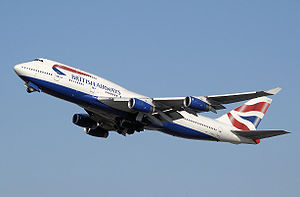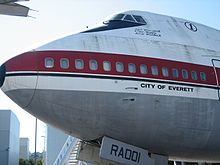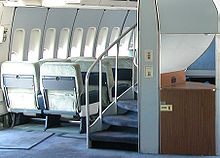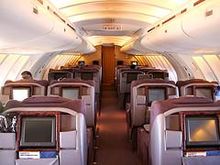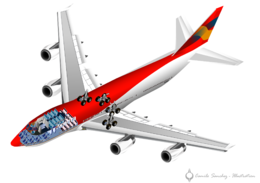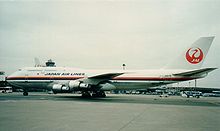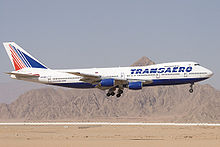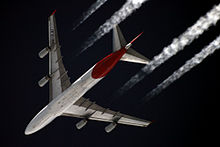- Boeing 747
-
Boeing 747 British Airways Boeing 747-400 during takeoff Role Wide-body, long-range jet airliner National origin United States Manufacturer Boeing Commercial Airplanes First flight February 9, 1969[1] Introduction January 22, 1970 with Pan Am[1] Status In service, and in production Primary users British Airways
Cathay Pacific
Korean Air
LufthansaProduced 1969–present Number built 1,418 as of September 2010[update][2] Unit cost 747-100: US$24 million (1967)
747-200: US$39 million (1976)
747-300: US$83 million (1982)
747-400: US$228–260 million (2007)
747-8I: US$317.5 million[3]
747-8F: US$319.3 millionVariants Boeing 747SP
Boeing 747-400
Boeing 747-8
Boeing VC-25
Boeing E-4Developed into Boeing YAL-1
Boeing 747 Large Cargo FreighterThe Boeing 747 is a wide-body commercial airliner and cargo transport, often referred to by its original nickname, Jumbo Jet, or Queen of the Skies. It is among the world's most recognizable aircraft,[4] and was the first wide-body ever produced. Manufactured by Boeing's Commercial Airplane unit in the United States, the original version of the 747 was two and a half times the size of the Boeing 707,[5] one of the common large commercial aircraft of the 1960s. First flown commercially in 1970, the 747 held the passenger capacity record for 37 years.[6]
The four-engine 747 uses a double deck configuration for part of its length. It is available in passenger, freighter and other versions. Boeing designed the 747's hump-like upper deck to serve as a first class lounge or (as is the general rule today) extra seating, and to allow the aircraft to be easily converted to a cargo carrier by removing seats and installing a front cargo door. Boeing did so because the company expected supersonic airliners (whose development was announced in the early 1960s) to render the 747 and other subsonic airliners obsolete, while believing that the demand for subsonic cargo aircraft would be robust into the future.[7] The 747 in particular was expected to become obsolete after 400 were sold[8] but it exceeded its critics' expectations with production passing the 1,000 mark in 1993.[9] As of June 2010, 1,418 aircraft have been built, with 109 more in various configurations remaining on order.[2]
The 747-400, the latest passenger version in service, is among the fastest airliners in service with a high-subsonic cruise speed of Mach 0.85–0.855 (up to 570 mph, 920 km/h). It has an intercontinental range of 7,260 nautical miles (8,350 mi or 13,450 km).[10] The 747-400 passenger version can accommodate 416 passengers in a typical three-class layout or 524 passengers in a typical two-class layout. The newest version of the aircraft, the 747-8, is in production and flight testing in late 2010. Deliveries of the 747-8F freighter version to the launch customer Cargolux began in October 2011; the 747-8I passenger version is to follow in 2012. The 747 is to be replaced by the Boeing Y3 (part of the Boeing Yellowstone Project) in the future.[11]
Contents
Development
Background
In 1963, the United States Air Force started a series of study projects on a very large strategic transport aircraft. Although the C-141 Starlifter was being introduced, they felt that a much larger and more capable aircraft was needed, especially the capability to carry outsized cargo that would not fit in any existing aircraft. These studies led to initial requirements for the CX-Heavy Logistics System (CX-HLS) in March 1964 for an aircraft with a load capacity of 180,000 pounds (81,600 kg) and a speed of Mach 0.75 (500 mph/805 km/h), and an unrefueled range of 5,000 nautical miles (9,260 km) with a payload of 115,000 pounds (52,200 kg). The payload bay had to be 17 feet (5.18 m) wide by 13.5 feet (4.11 m) high and 100 feet (30.5 m) long with access through doors at the front and rear.[12]
Featuring only four engines, the design also required new engine designs with greatly increased power and better fuel economy. On May 18, 1964, airframe proposals arrived from Boeing, Douglas, General Dynamics, Lockheed and Martin Marietta; while engine proposals were submitted by General Electric, Curtiss-Wright, and Pratt & Whitney. After a downselect, Boeing, Douglas and Lockheed were given additional study contracts for the airframe, along with General Electric and Pratt & Whitney for the engines.[12]
All three of the airframe proposals shared a number of features. As the CX-HLS needed to be able to be loaded from the front, a door had to be included where the cockpit usually was. All of the companies solved this problem by moving the cockpit to above the cargo area; Douglas had a small "pod" just forward and above the wing, Lockheed used a long "spine" running the length of the aircraft with the wing spar passing through it, while Boeing blended the two, with a longer pod that ran from just behind the nose to just behind the wing.[13] In 1965 Lockheed's aircraft design and General Electric's engine design were selected for the new C-5 Galaxy transport, which was the largest military aircraft in the world at the time.[12] The nose door and raised cockpit concepts would be carried over to the design of the 747.[14]
Airliner proposal
The 747 was conceived while air travel was increasing in the 1960s.[15] The era of commercial jet transportation, led by the enormous popularity of the Boeing 707 and Douglas DC-8, had revolutionized long-distance travel.[15][16] Even before it lost the CX-HLS contract, Boeing was pressed by Juan Trippe, president of Pan American World Airways (Pan Am), one of its most important airline customers, to build a passenger aircraft more than twice the size of the 707. During this time, airport congestion, worsened by increasing numbers of passengers carried on relatively small aircraft, became a problem that Trippe thought could be addressed by a large new aircraft.[17]
In 1965, Joe Sutter was transferred from Boeing's 737 development team to manage the studies for a new airliner, already assigned the model number 747.[18] Sutter initiated a design study with Pan Am and other airlines, in order to better understand their requirements. At the time, it was widely thought that the 747 would eventually be superseded by supersonic transport aircraft.[19] Boeing responded by designing the 747 so that it could be adapted easily to carry freight and remain in production even if sales of the passenger version declined. In the freighter role, the clear need was to support the containerized shipping methodologies that were being widely introduced at about the same time. Standard containers are 8 ft (2.4 m) square at the front (slightly higher due to attachment points) and available in 20 and 40 ft (6.1 and 12 m) lengths. This meant that it would be possible to support a 2-wide 2-high stack of containers two or three ranks deep with a fuselage size similar to the earlier CX-HLS project.
In April 1966, Pan Am ordered 25 747-100 aircraft for US$525 million. During the ceremonial 747 contract-signing banquet in Seattle on Boeing's 50th Anniversary, Juan Trippe predicted that the 747 would be "... a great weapon for peace, competing with intercontinental missiles for mankind's destiny", according to Malcolm T. Stamper, one of the senior management for the 747 program at the time.[4] As launch customer,[1][20] and because of its early involvement before placing a formal order, Pan Am was able to influence the design and development of the 747 to an extent unmatched by a single airline before or since.[21]
Design effort
Ultimately, the high-winged CX-HLS Boeing design was not used for the 747, although technologies developed for their bid had an influence.[22] The original design included a full-length double-deck fuselage with rows of eight-across seating and two aisles on the lower deck and seven-across seating and two aisles on the upper deck.[23] However, concern over evacuation routes and limited cargo-carrying capability caused this idea to be scrapped in early 1966 in favor of a wider single deck design.[1] The cockpit was, therefore, placed on a shortened upper deck so that a freight-loading door could be included in the nose cone; this design feature produced the 747's distinctive "bulge".[24] In early models it was not clear what to do with the small space in the pod behind the cockpit, and this was initially specified as a "lounge" area with no permanent seating.
The Pratt & Whitney JT9D high-bypass turbofan engine was developed for the 747.
One of the principal technologies that enabled an aircraft as large as the 747 to be conceived was the high-bypass turbofan engine.[25] The engine technology was thought to be capable of delivering double the power of the earlier turbojets while consuming a third less fuel. General Electric had pioneered the concept but was committed to developing the engine for the C-5 Galaxy and did not enter the commercial market until later.[26][27] Pratt & Whitney was also working on the same principle and, by late 1966, Boeing, Pan Am and Pratt & Whitney agreed to develop a new engine, designated the JT9D to power the 747.[27]
The project was designed with a new methodology called fault tree analysis, which allowed the effects of a failure of a single part to be studied to determine its impact on other systems.[1] To address concerns about safety and flyability, the 747's design included structural redundancy, redundant hydraulic systems, quadruple main landing gear and dual control surfaces.[28] Additionally, some of the most advanced high-lift devices used in the industry were included in the new design, in order to allow it to operate from existing airports. These included leading edge flaps running almost the entire length of the wing, as well as complex three-part slotted flaps along the rear.[29] The wing's complex three-part flaps increase wing area by 21 percent and lift by 90 percent when fully deployed compared to their non-deployed configuration.[30]
Boeing agreed to deliver the first 747 to Pan Am by the end of 1969. The delivery date left 28 months to design the aircraft, which was two-thirds of the normal time.[31] The schedule was so fast paced that the people who worked on it were given the nickname "The Incredibles".[32] Developing the aircraft was such a technical and financial challenge that management was said to have "bet the company" when it started the project.[1]
Production plant
 747 final assembly at the Boeing Everett Factory
747 final assembly at the Boeing Everett Factory
As Boeing did not have a plant large enough to assemble the giant airliner, they chose to build a new plant. The company considered locations in about 50 cities,[33] and eventually decided to build the new plant some 30 miles (48 km) north of Seattle on a site adjoining a military base at Paine Field near Everett, Washington.[34] It bought the 780-acre (3.2 km2) site in June 1966.[35]
Developing the 747 had been a major challenge, and building its assembly plant was also a huge undertaking. Boeing president William M. Allen asked Malcolm T. Stamper, then head of the company's turbine division, to oversee construction of the Everett factory and to start production of the 747.[36] To level the site, more than 4 million cubic yards (3.1 million m³) of earth had to be moved.[37] Time was so short that the 747's full-scale mock-up was built before the factory roof above it was finished.[38] The plant is the largest building by volume ever built, and has been substantially expanded several times to permit construction of other models of Boeing wide-body commercial jets.[34]
Development and testing
Before the first 747 was fully assembled, testing began on many components and systems. One important test involved the evacuation of 560 volunteers from a cabin mock-up via the aircraft's emergency chutes. The first full-scale evacuation took two and a half minutes instead of the maximum of 90 seconds mandated by the Federal Aviation Administration, and several volunteers were injured. Subsequent test evacuations achieved the 90-second goal but caused more injuries. Most problematic was evacuation from the aircraft's upper deck; instead of using a conventional slide, volunteer passengers escaped by using a harness attached to a reel.[39] Tests also involved taxiing such a large aircraft. Boeing built an unusual training device known as "Waddell's Wagon" (named for a 747 test pilot, Jack Waddell) that consisted of a mock-up cockpit mounted on the roof of a truck. While the first 747s were still being built, the device allowed pilots to practice taxi maneuvers from a high upper-deck position.[40]
On September 30, 1968, the first 747 was rolled out of the Everett assembly building before the world's press and representatives of the 26 airlines that had ordered the airliner.[41] Over the following months, preparations were made for the first flight, which took place on February 9, 1969, with test pilots Jack Waddell and Brien Wygle at the controls[42][43] and Jess Wallick at the flight engineer's station. Despite a minor problem with one of the flaps, the flight confirmed that the 747 handled extremely well. The 747 was found to be largely immune to "Dutch roll", a phenomenon that had been a major hazard to the early swept-wing jets.[44]
During later stages of the flight test program, flutter testing showed that the wings suffered oscillation under certain conditions. This difficulty was partly solved by reducing the stiffness of some wing components. However, a particularly severe high-speed flutter problem was solved only by inserting depleted uranium counterweights as ballast in the outboard engine nacelles of the early 747s.[45] This measure caused anxiety when these aircraft crashed, as did China Airlines Flight 358 at Wanli in 1991 and El Al Flight 1862 at Amsterdam in 1992.[46][47]
 Closeup of the 747 prototype's 16-wheel main undercarriage
Closeup of the 747 prototype's 16-wheel main undercarriage
The flight test program was hampered by problems with the 747's JT9D engines. Difficulties included engine stalls caused by rapid movements of the throttles and distortion of the turbine casings after a short period of service.[48] The problems delayed 747 deliveries for several months and stranded up to 20 aircraft at the Everett plant while they awaited engine installation.[49] The program was further delayed when one of the five test aircraft suffered serious damage during a landing attempt at Renton Municipal Airport, site of the Boeing Renton Factory. On December 13, 1969 the test aircraft was being taken to have its test equipment removed and a cabin installed when pilot Ralph C. Cokely undershot the airport's short runway. The 747's right, outer landing gear was torn off and two engine nacelles were damaged.[50][51] However, these difficulties did not prevent Boeing from taking one of the test aircraft to the 28th Paris Air Show in mid-1969, where it was displayed to the general public for the first time.[52] The 747 achieved its FAA airworthiness certificate in December 1969, making it ready for introduction into service.[53]
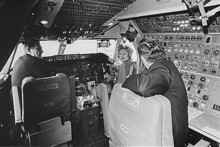 First Lady Pat Nixon visits the cockpit of the first commercial 747 during the christening ceremony, January 15, 1970.
First Lady Pat Nixon visits the cockpit of the first commercial 747 during the christening ceremony, January 15, 1970.
The huge cost of developing the 747 and building the Everett factory meant that Boeing had to borrow heavily from a banking syndicate. During the final months before delivery of the first aircraft, the company had to repeatedly request additional funding to complete the project. Had this been refused, Boeing's survival would have been threatened.[20][54] Ultimately, the gamble succeeded, and Boeing held a monopoly in very large passenger aircraft production for many years.[55]
Entry into service
On January 15, 1970, First Lady of the United States Pat Nixon christened Pan Am's first 747, Clipper Victor, at Dulles International Airport (later renamed Washington Dulles International Airport) in the presence of Pan Am chairman Najeeb Halaby. Instead of champagne, red, white and blue water was sprayed on the aircraft. The 747 entered service on January 22, 1970, on Pan Am's New York–London route;[56] the flight had been planned for the evening of January 21, but engine overheating made the original aircraft unusable. Finding a substitute delayed the flight by more than six hours to the following day.[57]
The 747 enjoyed a fairly smooth introduction into service, overcoming concerns that some airports would not be able to accommodate an aircraft that large.[58] Although technical problems occurred, they were relatively minor and quickly solved.[59] After the aircraft's introduction with Pan Am, other airlines that had bought the 747 in order to stay competitive began to put their own 747s into service.[60] Boeing estimated that half of the early 747 sales were to airlines desiring the aircraft's long range rather than its payload capacity.[61][62] While the 747 had the lowest potential operating cost per seat, this could only be achieved when the aircraft was fully loaded; costs per seat increased rapidly as occupancy declined. A moderately loaded 747, one with only 70 percent of its seats occupied, used more than 95 percent of the fuel needed by a fully occupied 747.[63]
When economic problems in the United States and other countries after the 1973 oil crisis led to reduced passenger traffic, several airlines found they did not have enough passengers to fly the 747 economically, and they replaced them with the smaller and recently introduced McDonnell Douglas DC-10 and Lockheed L-1011 TriStar trijet wide bodies[64] (and later the 767 and A300 twinjets). Having tried replacing coach seats on its 747s with piano bars in an attempt to attract more customers, American Airlines eventually relegated its 747s to cargo service and in 1983 exchanged them with Pan Am for smaller aircraft;[65] Delta Air Lines also removed its 747s from service after several years.[66] Delta would later merge with Northwest Airlines, which operates 747s.[67]
International flights that bypassed traditional hub airports and landed at smaller cities became more common throughout the 1980s, and this eroded the 747's original market.[68] However, many international carriers continued to use the 747 on Pacific routes.[69] In Japan, 747s on domestic routes are configured to carry close to the maximum passenger capacity.[70]
Improved 747 versions
After the initial 747-100 model, Boeing developed the −100B, a higher maximum takeoff weight (MTOW) variant, and the −100SR (Short Range), with higher passenger capacity.[71] Increased maximum takeoff weight can allow an aircraft to carry more fuel and have longer range.[72] The −200 model followed, entering service in 1971. It featured more powerful engines and higher takeoff weight. Passenger, freighter and combination passenger-freighter versions were produced.[71] The shortened 747SP (special performance) with a longer range was also developed in the mid-1970s.[73]
The 747 line was further developed with the launching of the 747-300 in 1980. The −300 resulted from Boeing studies to increase the seating capacity of the 747. Solutions such as fuselage plugs and extending the upper deck over the entire length of the fuselage were rejected. The early designation of the −300 was 747SUD for "stretched upper deck", then 747-200 SUD,[74] followed by 747EUD, before the 747-300 designation was used.[75] The −300 model was first produced in 1983. It included a stretched upper deck, increased cruise speed and increased seating capacity. Passenger, short range and combination freighter-passenger versions were produced.[71]
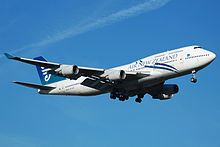 The 747-400 entered service in 1989, with Air New Zealand among the first operators of the type.
The 747-400 entered service in 1989, with Air New Zealand among the first operators of the type.
In 1985, development of the longer range 747-400 began.[76] The new variant had a new glass cockpit, which allowed for a cockpit crew of two instead of three.[77] Development cost soared, and production delays occurred as new technologies were incorporated at the request of airlines. Insufficient workforce experience and reliance on overtime contributed to early production problems on the 747-400.[1] The −400 entered service in 1989.[78]
In 1991, a record-breaking 1,087 passengers were airlifted aboard a 747 to Israel as part of Operation Solomon.[79] The 747 was the heaviest airliner in regular service until the use of the Antonov An-124 Ruslan in 1982. The 747-400ER model regained that distinction in 2000. The Antonov An-225 cargo transport remains the world's largest aircraft by several measures (including the most accepted measures of maximum takeoff weight and length); one has been completed and is in service as of 2010[update]. The Hughes H-4 Hercules is the largest aircraft by wingspan, but it only flew once.[80]
Further developments
Since the arrival of the 747-400, several stretching schemes for the 747 have been proposed. Boeing announced the larger 747-500X and -600X preliminary designs in 1996.[81] The new variants would have cost more than US$5 billion to develop,[81] and interest was not sufficient to launch the program.[82] Boeing offered the more modest 747X and 747X stretch derivatives in 2000 as alternatives to the Airbus A3XX. However, the 747X family was unable to attract enough interest to enter production. Boeing switched from the 747X studies to pursue the Sonic Cruiser in 2001[83] and, after the Sonic Cruiser program was put on hold, the 787.[84] Some of the ideas developed for the 747X were used on the 747-400ER.[85]
After several variants were proposed but later abandoned, some industry observers became skeptical of new aircraft proposals from Boeing.[86] However, in early 2004, Boeing announced tentative plans for the 747 Advanced that were eventually adopted. Similar in nature to the 747-X, the stretched 747 Advanced used technology from the 787 to modernize the design and its systems. The 747 remained the largest passenger airliner in service until the Airbus A380 began airline service in 2007.[87]
On November 14, 2005, Boeing announced it was launching the 747 Advanced as the Boeing 747-8.[88] The last 747-400s were completed in 2009.[89] As of 2011[update], most orders of the 747-8 have been for the freighter variant. On February 8, 2010, the 747-8 Freighter made its maiden flight.[90] The first scheduled delivery of the 747-8 will be to Cargolux in mid-2011.[91][92] Eventually, the 747 may be replaced in Boeing's lineup by a new design dubbed "Y3".
Design
The Boeing 747 is a large, wide-body (two-aisle) airliner with four wing-mounted engines. The wings have a high sweep angle of 37.5 degrees for a fast, efficient cruise[24] of Mach 0.84 to 0.88, depending on the variant. The sweep also allows the 747 to use existing hangars.[1][93] Seating capacity is more than 366 with a 3–4–3 seat arrangement (a cross section of 3 seats, an aisle, 4 seats, another aisle, and 3 seats) in economy class and a 2–3–2 arrangement in first class on the main deck. The upper deck has a 3–3 seat arrangement in economy class and a 2–2 arrangement in first class.[94]
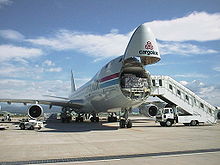 Cargolux 747-400F with the nose loading door open
Cargolux 747-400F with the nose loading door open
Raised above the main deck, the cockpit creates a hump. The raised cockpit is to allow front loading of cargo on freight variants.[24] The upper deck behind the cockpit provides space for a lounge or extra seating. The "stretched upper deck" became available as an option on the 747-100B variant and later as standard on the 747-300. The 747-400 cockpit roof section also has an escape hatch from which crew can exit in the event of an emergency if they cannot exit through cabin.
The 747's maximum takeoff weight ranges from 735,000 pounds (333,400 kg) for the −100 to 970,000 lb (439,985 kg) for the −8. Its range has increased from 5,300 nautical miles (6,100 mi, 9,800 km) on the −100 to 8,000 nmi (9,200 mi, 14,815 km) on the −8I.[95][96]
The 747 has multiple structural redundancy including four redundant hydraulic systems and four main landing gears with four wheels each, which provide a good spread of support on the ground and safety in case of tire blow-outs. The redundant main gear allows for landing on two opposing landing gears if the others do not function properly.[97] In addition, the 747 has split control surfaces and sophisticated triple-slotted flaps that minimize landing speeds and allow the 747 to use standard-length runways.[98] For transportation of spare engines, 747s can accommodate a non-functioning fifth-pod engine under the port wing of the aircraft between the inner functioning engine and the fuselage.[99][100]
Variants
Boeing 747 variants ICAO code[101] Model(s) B741 747-100/100B B742 747-200/200B/200M/E-4/VC-25 B743 747-300/300M B744 747-400/400C/400ER/400ERF/400F B74D 747-400D B74S 747SP B74R 747-100SR/100BSR BLCF 747-400LCF Dreamlifter BSCA 747 Shuttle Carrier Aircraft B748 747-8F/8I The 747-100 was the original variant launched in 1966. The 747-200 soon followed, with an order in 1968. The 747-300 was launched in 1980 and was followed in 1985 by the 747-400. Ultimately, the 747-8 was announced in 2005. Several versions of each variant have been produced, and many of the early variants were in production simultaneously. The International Civil Aviation Organization (ICAO) classifies variants using a shortened code formed by combining the model number and the variant designator (e.g. "B741" for all −100 models).[101]
747-100
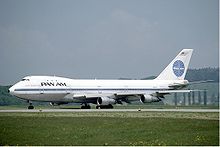 Pan Am was the first airline to operate the 747. The 747-100 pictured shows the original size of the upper deck and window layout.
Pan Am was the first airline to operate the 747. The 747-100 pictured shows the original size of the upper deck and window layout.
The first 747-100s were built with six upper-deck windows (three per side) to accommodate upstairs lounge areas. Later, as airlines began to use the upper-deck for premium passenger seating instead of lounge space, Boeing offered a ten-window upper deck as an option. Some −100s were retrofitted with the new configuration.[102] The −100 was equipped with Pratt & Whitney JT9D-3A engines. No freighter version of this model was developed by Boeing. However, 747-100s have been converted to freighters.[103] A total of 167 747-100s were built.
747SR
Responding to requests from Japanese airlines for a high-capacity aircraft to serve domestic routes between major cities, Boeing developed the 747SR as a "short range" variant of the 747-100 with lower fuel capacity and greater payload capability. With increased economy class seating, up to 498 passengers could be carried in early versions and more than 550 in later models.[71] The 747SR had an "economic design life objective" of 52,000 flights during 20 years of airline operation, compared to 24,600 flights in 20 years for the standard 747.[104] The initial 747SR model, the −100SR, had a strengthened body structure and undercarriage to accommodate the added stress accumulated from a greater number of takeoffs and landings.[105] Extra structural support was built into the wings, fuselage, and the landing gear along with a 20 percent reduction in fuel capacity.[106]
One of two 747-100BSR SUD models built for Japan Airlines
The initial order for the −100SR, four aircraft for Japan Air Lines (JAL, later Japan Airlines), was announced on October 30, 1972; rollout occurred on August 3, 1973, and the first flight took place on August 31, 1973. The type was certified by the FAA on September 26, 1973, with the first delivery on the same day. The −100SR entered service with JAL, the type's sole customer, on October 7, 1973, and typically operated Japanese domestic flights.[35] Seven −100SRs were built from 1973 and 1975, each with a 520,000-pound (240,000 kg) MTOW and Pratt & Whitney JT9D-7A engines derated to 43,000 pounds-force (190,000 N) of thrust.[107]
Following the −100SR, Boeing produced the −100BSR, a 747SR variant with increased takeoff weight capability. Debuting in 1978, the −100BSR also incorporated structural modifications for a high cycle-to-flying hour ratio; a related standard −100B model debuted in 1979. The −100BSR first flew on November 3, 1978, with first delivery to All Nippon Airways (ANA) on December 21, 1978. A total of 20 −100BSRs were produced for ANA and JAL.[108] The −100BSR had a 600,000 lb MTOW and was powered by the same JT9D-7A engines used on the −100SR. ANA operated the type on domestic Japanese routes with 455 or 456 seats until retiring its last aircraft on March 10, 2006.[109]
In 1986, two −100BSR SUD models, featuring the stretched upper deck (SUD) of the −300, were produced for JAL.[110] The type's maiden flight occurred on February 26, 1986, with FAA certification and first delivery on March 24, 1986.[111] JAL operated the −100BSR SUD with 563 seats on domestic routes until their retirement in the third quarter of 2006. While only two −100BSR SUDs were produced, in theory, standard −100Bs can be modified to the SUD certification.[108] Overall, 29 747SRs were built,[2] including seven −100SR, 20 −100BSR, and two −100BSR SUD models.
 The sole Iran Air 747-100B in passenger service
The sole Iran Air 747-100B in passenger service
747-100B
The 747-100B model was developed from the −100SR, utilizing its stronger airframe and undercarriage design. The type had an increased fuel capacity of 48,070 US gallons, allowing for a 5,000-nautical-mile (9,300 km; 5,800 mi) range with a typical 452-passenger payload, and an increased MTOW of 750,000 lb (340,000 kg) was offered. The first −100B order, one aircraft for Iran Air, was announced on June 1, 1978. This aircraft first flew on June 20, 1979, received FAA certification on August 1, 1979, and was delivered the next day.[112] Nine −100Bs were built, one for Iran Air and eight for Saudia (now Saudi Arabian Airlines).[113][114] Unlike the original −100, the −100B was offered with Pratt & Whitney JT9D-7A, General Electric CF6-50, or Rolls-Royce RB211-524 engines. However, only RB211-524 (Saudia) and JT9D-7A (Iran Air) engines were ordered.[115]
747SP
Main article: Boeing 747SPThe idea for the 747SP came from a joint request between Pan American World Airways and Iran Air, who were looking for a high-capacity airliner with enough range to cover Pan Am's New York–Middle Eastern routes and Iran Air's planned Tehran–New York route. The Tehran–New York route when launched was the longest non-stop commercial flight in the world. The 747SP is 48 feet 4 inches (14.73 m) shorter than the 747-100. Fuselage sections were eliminated fore and aft of the wing, and the center section of the fuselage was redesigned. The SP's flaps used a simplified single-slotted configuration.[116][117] The 747SP, compared to earlier variants, had a tapering of the aft upper fuselage into the empennage, a double-hinged rudder, and longer vertical and horizontal stabilizers.[118] Power was provided by Pratt & Whitney JT9D-7(A/F/J/FW) or Rolls-Royce RB211-524 engines.[119]
The 747SP was granted a supplemental certificate on February 4, 1976 and entered service with Pan Am, the launch customer and Iran Air, that same year.[117] The aircraft was chosen by airlines wishing to serve major airports with short runways.[120]
A total of 45 747SPs were built.[2] The 44th 747SP was delivered on August 30, 1982. Boeing re-opened the 747SP production line to build one last 747SP five years later in 1987 for an order by the United Arab Emirates government.[117] In addition to airline use, one 747SP was modified for NASA Dryden Flight Research Center's SOFIA experiment.[121]
747-200
While the −100 powered by Pratt & Whitney JT9D-3A engines offered enough payload and range for US domestic operations, it was marginal for long international route sectors. The demand for longer range aircraft with increased payload quickly led to the improved −200, which featured more powerful engines, increased MTOW, and greater range than the −100. In its first three years of production, the −200 was equipped with Pratt & Whitney JT9D-7 engines (initially the only engine available). A few early −200s retained the three-window configuration of the −100 on the upper deck, but most were built with a ten-window configuration on each side.[122] The −200 was produced in passenger (−200B), freighter (−200F), convertible (−200C), and combi (−200M) versions.[123]
The 747-200B was the basic passenger version, with increased fuel capacity and more powerful engines; it entered service in February 1971.[74] Range with a full passenger load started at over 5,000 nmi (9,300 km) and increased to 6,000 nmi (11,000 km) with later engines. Most −200Bs had an internally stretched upper deck, allowing for up to 16 passenger seats.[124] The freighter model, the 747-200F, could be fitted with or without a side cargo door,[74] and had a capacity of 105 tons (95.3 tonnes) and an MTOW of up to 833,000 lb (378,000 kg). It entered service in 1972 with Lufthansa.[125] The convertible version, the 747-200C, could be converted between a passenger and a freighter or used in mixed configurations,[71] and featured removable seats and a nose cargo door.[74] The −200C could also be fitted with an optional side cargo door on the main deck.[126]
The combi model, the 747-200M, could carry freight in the rear section of the main deck via a side cargo door. A removable partition on the main deck separated the cargo area at the rear from the passengers at the front. The −200M could carry up to 238 passengers in a three-class configuration if cargo was carried on the main deck. The model was also known as the 747-200 Combi.[74] As on the −100, a stretched upper deck (SUD) modification was later offered. A total of 10 converted 747-200s were operated by KLM.[74] Union des Transports Aériens (UTA) also had two of these aircraft converted.[127][128]
 Air France 747-200M in landing configuration
Air France 747-200M in landing configuration
After launching the −200 with Pratt & Whitney JT9D-7 engines, on August 1, 1972 Boeing announced that it had reached an agreement with General Electric to certify the 747 with CF6-50 series engines to increase the aircraft's market potential. Rolls-Royce followed 747 engine production with a launch order from British Airways for four aircraft. The option of RB211-524B engines was announced on June 17, 1975.[115] The −200 was the first 747 to provide a choice of powerplant from the three major engine manufacturers.[129]
A total of 393 of the 747-200 versions had been built when production ended in 1991.[130] Of these, 225 were −200s, 73 were −200F, 13 were −200C, 78 were −200M, and 4 were military.[131] Many 747-200s remain in operation, although most large carriers have retired them from their fleets and sold them to smaller operators. Large carriers have sped up fleet retirement following the September 11 attacks and the subsequent drop in demand for air travel, scrapping some or turning others into freighters.[132][133]
747-300
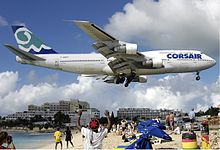 A Corsair Boeing 747-300 landing at Princess Juliana Airport in Saint Maarten in 2007.
A Corsair Boeing 747-300 landing at Princess Juliana Airport in Saint Maarten in 2007.
The most visible difference between the −300 and previous models was a stretched upper deck with two new emergency exit doors and an optional flight-crew rest area immediately aft of the flight deck as standard. Compared to the −200, the upper deck is 23 feet 4 inches (7.11 m) longer.[75] The stretched upper deck had previously been offered as a retrofit and first appeared on two Japanese 747-100SR aircraft.[134] The −300 has a new straight stairway to the upper deck instead of a spiral staircase on earlier variants.[71] The staircase creates room below and above for more seats. With minor aerodynamic changes, Boeing increased the −300's cruise speed to Mach 0.85 from Mach 0.84 on the −200 and −100 models.[75] The −300 features the same takeoff weight. For available engines on the −300, the Pratt & Whitney and Rolls-Royce engine versions were unchanged from the −200, but the General Electric engine changed to the CF6-80C2B1 version.[71]
The 747-300 designation, which was first used in a design study that was later shelved, was revived for this version, which was introduced in 1980. Swissair ordered the first 747-300 on June 11, 1980.[135] The 747-300 first flew on October 5, 1982. Swissair was the first customer to accept delivery on March 23, 1983.[35] In addition to the passenger version, two other versions (−300M, −300SR) were available. The 747-300M has cargo capacity in the rear portion of the main deck similar to the −200M, but with the stretched upper deck it can carry more passengers.[119][136] The 747-300SR is a short range version to meet the need for a high-capacity domestic model. Japan Airlines operated such aircraft with more than 600 seats on the Okinawa–Tokyo route and elsewhere. Boeing never launched a newly built freighter version of the 747-300, but it modified used passenger −300 models into freighters starting in 2000.[137]
A total of 81 aircraft were delivered, 56 for passenger use, 21 −300M and 4 −300SR versions.[138] The 747-300 was soon superseded by the more advanced 747-400 in 1985, just two years after the −300 entered service.[139] The last 747-300 was delivered in September 1990 to Sabena.[71][140] Today, many −300 aircraft are still active, despite several large carriers that replaced their 747-300s with 747-400s. Air France, Air India, Pakistan International Airlines and Qantas were some of the last major carriers to operate the 747-300. On December 29, 2008, Qantas flew its last scheduled 747-300 service, operating from Melbourne to Los Angeles via Auckland.[141]
747-400
Main article: Boeing 747-400The 747-400 is an improved model with increased range. It has wing-tip extensions of 6 ft (1.8 m) and winglets of 6 ft (1.8 m), which improve the 747-400's fuel efficiency by four percent compared to previous 747 versions.[142] It has a new glass cockpit designed for a flight crew of two instead of three. The use of electronics reduced the number of dials, gauges and knobs from 971 to 365. It has tail fuel tanks, revised engines and a new interior. The longer range was used by some airlines to bypass traditional fuel stops, such as Anchorage.[143] Powerplants include the Pratt & Whitney PW4062, General Electric CF6-80C2, and Rolls-Royce RB211-524.[144]
The −400 was offered in passenger (−400), freighter (−400F), combi (−400C), domestic (−400D), extended range passenger (−400ER) and extended range freighter (−400ERF) versions. The freighter version does not have an extended upper deck.[145] The 747-400D was built for short range operations and does not include winglets, but these can be retrofitted.[146] Cruising speed is up to Mach 0.855 on different versions of the 747-400.[144][147]
 British Airways is the world's largest 747-400 operator. Winglets distinguish most −400s from earlier variants.
British Airways is the world's largest 747-400 operator. Winglets distinguish most −400s from earlier variants.
The passenger version first entered service in February 1989 with launch customer Northwest Airlines on the Minneapolis to Phoenix route.[78] The combi version entered service in September 1989 with KLM. The freighter version entered service in November 1993 with Cargolux. The 747-400ERF entered service in October 2002 and the 747-400ER entered service the following month with Qantas,[148] the only airline ever to order the passenger version. In January 2004 Boeing and Cathay Pacific launched the Boeing 747-400 Special Freighter program,[149] later referred to as the Boeing Converted Freighter (BCF). The first 747-400BCF was redelivered in December 2005.[150]
The last passenger version of the 747-400 was delivered in April 2005 to China Airlines. Some of the last built Boeing 747-400s were delivered with Dreamliner livery along with the modern Signature interior from the Boeing 777. Boeing announced in March 2007 that it had no plans to produce further passenger versions of the −400.[151] However, orders for 36 −400F and −400ERF freighters were already in place at the time of the announcement.[151] A total of 694 of the 747-400 series aircraft had been delivered.[2] At various times, the largest operator of the 747-400 has been Singapore Airlines,[152] Japan Airlines,[152] or British Airways.[153]
747 LCF Dreamlifter
 The Boeing 747 Large Cargo Freighter, also called Dreamlifter, is modified from 747-400s previously in airline use.
The Boeing 747 Large Cargo Freighter, also called Dreamlifter, is modified from 747-400s previously in airline use. Main article: Boeing 747 Large Cargo Freighter
Main article: Boeing 747 Large Cargo FreighterThe 747-400 Dreamlifter[154] (originally called the 747 Large Cargo Freighter or LCF[155]) is a Boeing-designed modification of existing 747-400s to a larger configuration to ferry Boeing 787 Dreamliner sub-assemblies to the Boeing plant in Everett, Washington, for final assembly. Evergreen Aviation Technologies Corporation of Taiwan was contracted to complete modifications of 747-400s into Dreamlifters in Taiwan. The aircraft flew for the first time on September 9, 2006 in a test flight.[156] The Dreamlifter's intended purpose is to transport sub-assemblies for the Boeing 787.[154] The aircraft is certified to carry only essential crew and not passengers.[157] Modification of four aircraft was completed by February 2010.[158]
747-8
Main article: Boeing 747-8Boeing announced a new 747 variant, the 747-8 (referred to as the 747 Advanced prior to launch) on November 14, 2005. The variant will use the same engine and cockpit technology as the 787, hence the use of the "8". Plans call for the new design to be quieter, more economical and more environmentally friendly. The 747-8's fuselage was lengthened from 232 to 251 feet (70.8 to 76.4 m).[159] When the 747-8 enters service, it will surpass the Airbus A340-600 as the world's longest airliner. The 747-8 is equipped with General Electric GEnx-2B67 engines.[144]
 The first Boeing 747-8 freighter on its maiden flight
The first Boeing 747-8 freighter on its maiden flight
The 747-8 Freighter version or 747-8F is derived from the 747-400ERF. The 747-8F can accommodate 154 tons (140 tonnes) of cargo. To aid loading and unloading, it features an overhead nose-door. It has 16 percent more payload capacity than the 747-400F and can hold seven additional standard air cargo containers.[160] The 747-8 Freighter made its maiden flight on February 8, 2010.[161][162] Deliveries of the 747-8F are to begin in mid-2011.[163]
The passenger version, named 747-8 Intercontinental or 747-8I, will be able to carry up to 467 passengers in a 3-class configuration and fly more than 8,000 nmi (15,000 km) at Mach 0.855. As a derivative of the already common 747-400, the 747-8 has the economic benefit of similar training and interchangeable parts.[164] The 747-8I is to begin deliveries in late 2011.[163] The first test flight was on March 20, 2011.[165]
Several units are under construction at Boeing's Everett facility. The 747-8 has received 126 total orders with 76 for the −8F, and 50 for the −8I as of June 2011.[2]
Government, military and other variants
 VC-25A 29000, one of the two customized Boeing 747-200Bs that have been part of the U.S. presidential fleet since 1990
VC-25A 29000, one of the two customized Boeing 747-200Bs that have been part of the U.S. presidential fleet since 1990
- C-19 – The U.S. Air Force gave this designation to the 747-100s used by some U.S. airlines and modified for use in the Civil Reserve Airlift Fleet.[166]
- VC-25 – This aircraft is the U.S. Air Force Very Important Person (VIP) version of the 747-200B. The U.S. Air Force operates two of them in VIP configuration as the VC-25A. Tail numbers 28000 and 29000 are popularly known as Air Force One, which is technically the air-traffic call sign for any United States Air Force aircraft carrying the U.S. President. Although based on the 747-200B design, they include several innovations introduced on the 747-400. Partially completed aircraft from Everett, Washington, were flown to Wichita, Kansas, for final outfitting.
- E-4B – Formerly known as the National Emergency Airborne Command Post (referred to colloquially as "Kneecap"), this aircraft is now referred to as the National Airborne Operations Center (NAOC).
- YAL-1 – This is the experimental Airborne Laser, a component of the National Missile Defense plan.
- Shuttle Carrier Aircraft – Two 747s were modified to carry the Space Shuttle. One is a 747-100 (N905NA), and the other is a 747-100SR (N911NA). An SCA carried the Space Shuttle Enterprise in the late 1970s, and has since carried all Space Shuttles.
 20-1101 Japanese Air Force One, one of the two customized Boeing 747-400s that have been part of the Japan Air Self-Defense Force since 1993
20-1101 Japanese Air Force One, one of the two customized Boeing 747-400s that have been part of the Japan Air Self-Defense Force since 1993
- A number of other governments also use the 747 as a VIP transport, including Bahrain, Brunei, India, Iran, Japan, Kuwait, Oman, Pakistan, Qatar, Saudi Arabia and United Arab Emirates. Several new Boeing 747-8s have been ordered by Boeing Business Jet for conversion to VIP transport for several unidentified customers.[167]
- C-33 – This aircraft was a proposed U.S. military version of the 747-400 intended to augment the C-17 fleet. The plan was canceled in favor of additional C-17 military transports.
- KC-33A – A proposed 747 was also adapted as an aerial refueling tanker and was bid against the DC-10-30 during the 1970s Advanced Cargo Transport Aircraft (ACTA) program that produced the KC-10A Extender. Before the Khomeini-led revolution, Iran bought four 747-100 aircraft with air-refueling boom conversions to support a fleet of F-4 Phantoms.[168][169] It is unknown whether these aircraft remain usable as tankers. Since then, other proposals have emerged for adaptation of later 747-400 aircraft for this role.[168]
- 747 CMCA – This variant was considered by the U.S. Air Force as a Cruise Missile Carrier Aircraft during the development of the B-1 Lancer strategic bomber. It would have been equipped with 50 to 100 AGM-86 ALCM cruise missiles on rotary launchers. This plan was abandoned in favor of more conventional strategic bombers.[170]
- 747 AAC – Boeing also considered developing the 747 into an aerial aircraft carrier for up to 10 "microfighters". With a double-decker hangar and two launching bays, it was believed that the scheme might actually be cheaper than establishing a short-term land base. However nothing came of the scheme, or its complementary 747 AWACS version, which would have carried two of the "microfighters" for reconnaissance.[171]
- Evergreen 747 Supertanker – A Boeing 747-200 modified as an aerial application platform for fire fighting using 20,000 US gallons (76,000 L) of firefighting chemicals.[172]
- Stratospheric Observatory for Infrared Astronomy (SOFIA) - A former Pan Am Boeing 747SP modified to carry a large infrared-sensitive telescope, in a joint venture of NASA and DLR. High altitudes are needed for infrared astronomy, so as to rise above infrared-absorbing water vapor in the atmosphere.
Undeveloped variants
Boeing has studied a number of 747 variants that have not gone beyond the concept stage.
747 trijet
During the late 1960s and early 1970s, Boeing studied the development of a shorter 747 with three engines, to compete with the smaller L-1011 TriStar and DC-10. The 747 trijet would have had more payload, range, and passenger capacity. The center engine would have been fitted in the tail with an S-duct intake similar to the L-1011's. However, engineering studies showed that a total redesign of the 747 wing would be necessary. Maintaining the same 747 handling characteristics would be important to minimize pilot retraining. Boeing decided instead to pursue a shortened four-engine 747, resulting in the 747SP.[173] In the 1990s, the Boeing 777, a long-range twinjet airliner smaller than the 747-400, entered service in the market where the 747 trijet had been targeted.[117]
747-500X, −600X and −700X
 The proposed 747-500X and −600X as depicted in an 1998 FAA illustration
The proposed 747-500X and −600X as depicted in an 1998 FAA illustration
Boeing announced the 747-500X and −600X at the 1996 Farnborough Airshow.[81] The proposed models would have combined the 747's fuselage with a new 251 ft (77 m) span wing derived from the 777. Other changes included adding more powerful engines and increasing the number of tires from two to four on the nose landing gear and from 16 to 20 on the main landing gear.[174]
The 747-500X concept featured an increased fuselage length of 18 ft (5.5 m) to 250 ft (76.2 m) long, and the aircraft was to carry 462 passengers over a range up to 8,700 nautical miles (10,000 mi, 16,100 km), with a gross weight of over 1.0 Mlb (450 Mg).[174] The 747-600X concept featured a greater stretch to 279 ft (85 m) with seating for 548 passengers, a range of up to 7,700 nmi (8,900 mi, 14,300 km), and a gross weight of 1.2 Mlb (540 Mg).[174] A third study concept, the 747-700X, would have combined the wing of the 747-600X with a widened fuselage, allowing it to carry 650 passengers over the same range as a 747-400.[81] The cost of the changes from previous 747 models, in particular the new wing for the 747-500X and −600X, was estimated to be more than US$5 billion.[81] Boeing was not able to attract enough interest to launch the aircraft.[82]
747X and 747X Stretch
As Airbus progressed with its A3XX study, Boeing in 2000 offered the market a 747 derivative as an alternative. This was a more modest proposal than the previous −500X and −600X that would retain the 747's overall wing design and add a segment at the root, increasing the span to 229 ft (69.8 m).[175] Power would have been supplied by either the Engine Alliance GP7172 or the Rolls-Royce Trent 600, which were also proposed for the 767-400ERX.[176] A new flight deck based on the 777's would be used. The 747X aircraft was to carry 430 passengers over ranges of up to 8,700 nmi (10,000 mi, 16,100 km). The 747X Stretch would be extended to 263 ft (80.2 m) long, allowing it to carry 500 passengers over ranges of up to 7,800 nmi (9,000 mi, 14,500 km).[175] Both would feature an interior based on the 777's signature architecture.[177] Freighter versions of the 747X and 747X Stretch were also studied.[178]
Like its predecessor, the 747X family was unable to garner enough interest to justify production, and it was shelved along with the 767-400ERX in March 2001, when Boeing announced the Sonic Cruiser concept.[83] Though the 747X design was less costly than the 747-500X and −600X, it was criticized for not offering a sufficient advance from the existing 747-400. The 747X did not make it beyond the drawing board, but the 747-400X being developed concurrently moved into production to become the 747-400ER.[179]
747-400XQLR
After the end of the 747X program, Boeing continued to study improvements that could be made to the 747. The 747-400XQLR (Quiet Long Range) was meant to have an increased range of 7,980 nmi (9,200 mi, 14,800 km), with improvements to boost efficiency and reduce noise.[180][181] Improvements studied included raked wingtips similar to those used on the 767-400ER and a sawtooth engine nacelle for noise reduction.[182] Although the 747-400XQLR did not move to production, many of its features were used for the 747 Advanced, which has now been launched as the 747-8.
Operators
Main article: List of Boeing 747 operatorsYear Total 2011 2010 2009 2008 2007 2006 2005 2004 2003 2002 2001 2000 1999 1998 1997 1996 1995 1994 1993 1992 1991 1990 Orders 1527 2 1 5 2 25 68 48 10 4 17 16 26 35 15 36 56 32 16 2 23 31 122 Deliveries 1418 1 0 8 14 16 14 13 15 19 27 31 25 47 53 39 26 25 40 56 61 64 70 Year 1989 1988 1987 1986 1985 1984 1983 1982 1981 1980 1979 1978 1977 1976 1975 1974 1973 1972 1971 1970 1969 1968 1967 1966 Orders 56 49 66 84 42 23 24 14 23 49 72 76 42 14 20 29 29 18 7 20 30 22 43 83 Deliveries 45 24 23 35 24 16 22 26 53 73 67 32 20 27 21 22 30 30 69 92 4 – – – - Data through March 2011, table updated on April 8, 2011.[183]
Accidents and incidents
Main article: Boeing 747 hull lossesAs of September 2010, the 747 has been involved in 124 accidents or incidents,[184] including 49 hull-loss accidents,[185] resulting in 2,852 fatalities. The 747 has been in 31 hijackings, which caused 25 fatalities.[186]
Few crashes have been attributed to design flaws of the 747. The Tenerife disaster resulted from pilot error, air traffic control (ATC) error and communications failure, while the Japan Airlines Flight 123 and China Airlines Flight 611 crashes stemmed from improper aircraft repair. United Airlines Flight 811, which suffered an explosive decompression mid-flight on February 24, 1989, led the National Transportation Safety Board (NTSB) to issue a recommendation that 747-200 cargo doors similar to those on the Flight 811 aircraft be modified. Korean Air Lines Flight 007 was shot down by the Soviets in 1983 after it had strayed into Soviet territory, causing U.S. President Ronald Reagan to authorize the then-strictly military Global Positioning System (GPS) for civilian use.[187] TWA Flight 800, a 747-100 that exploded in midair on July 17, 1996, led the Federal Aviation Administration to propose a rule requiring installation of an inerting system in the center fuel tank of most large aircraft that was adopted in July 2008, after years of research into solutions. It is expected that the new safety system will cost US$100,000 to $450,000 per aircraft and weigh approximately 200 pounds (91 kg).[188]
Aircraft on display
Boeing 747-200B on display at the Technikmuseum Speyer in GermanyBoeing 747-128 on display at the Musée de l'Air et de l'Espace in FranceAs increasing numbers of "classic" 747-100 and 747-200 series aircraft have been retired, some have found their way into museums or other uses. The City of Everett, the first 747 and prototype is at the Museum of Flight, Seattle, Washington, USA where it is sometimes leased to Boeing for test purposes.[189]
Other 747s in museums include those at the National Aviation Theme Park Aviodrome, Lelystad, Netherlands; the Qantas Founders Outback Museum, Longreach, Queensland, Australia; Rand Airport, Johannesburg, South Africa; Technikmuseum Speyer, Speyer, Germany; Musée de l'Air et de l'Espace, Paris, France; Tehran Aerospace Exhibition, Tehran, Iran; Jeongseok Aviation Center, Jeju, South Korea,[190] Evergreen Aviation & Space Museum, McMinnville, Oregon, and the National Air and Space Museum, Washington, D.C.[191]
Upon its retirement from service, the 747 number two in the production line was dis-assembled and shipped to Hopyeong, Namyangju, Gyeonggi-do, South Korea where it was re-assembled and converted into a restaurant. Originally flown commercially by Pan Am as N747PA "Clipper Juan T. Trippe", and repaired for service following a tailstrike, it stayed with the airline until its bankruptcy. The 747 restaurant closed by 2009,[192] and the B747 was demolished in 2010.[193] The Jumbohostel, using a converted 747-200, opened at Arlanda Airport, Stockholm on January 15, 2009.[194]
Specifications
Measurement 747-100B 747-200B 747-300 747-400
747-400ER747-8I Cockpit Crew Three Two Typical seating capacity 452 (2-class)
366 (3-class)496 (2-class)
412 (3-class)524 (2-class)
416 (3-class)467 (3-class) Length 231 ft 10 in (70.6 m) 250 ft 2 in (76.25 m) Interior cabin width 20 feet (6.1 m) Wingspan 195 ft 8 in (59.6 m) 211 ft 5 in (64.4 m) 224 ft 7 in (68.5 m) Wing area 5,500 ft2 (510.95 m2) 5,650 ft2 (525 m2) 5963 ft2 (554 m2) Wing sweep 37.5º Aspect ratio 6.9 7.9 8.5 Tail height 63 ft 5 in (19.3 m) 63 ft 8 in (19.4 m) 63 ft 6 in (19.4 m) Operating empty weight 358,000 lb
(162,400 kg)383,000 lb
(174,000 kg)392,800 lb
(178,100 kg)393,263 lb
(178,756 kg)
ER: 406,900 lb
(184,600 kg)472,900 lb
(214,503 kg)Maximum takeoff weight 735,000 lb
(333,390 kg)833,000 lb
(377,842 kg)875,000 lb
(396,890 kg)
ER: 910,000 lb
(412,775 kg)975,000 lb
(442,253 kg)Cruising speed
(at 35,000 ft (11,000 m) altitude)Mach 0.84
(555 mph, 893 km/h, 481 knots )Mach 0.85
(567 mph, 913 km/h, 493 kn)
ER: Mach 0.855
(570 mph, 918 km/h, 495 kn)Mach 0.855
(570 mph, 918 km/h, 495 kn)Maximum speed Mach 0.89
(594 mph, 955 km/h, 516 kn)Mach 0.92
(614 mph, 988 km/h, 533 kn)Required runway at MTOW* 10,466 ft (3,190 m) 10,893 ft (3,320 m) 9,902 ft (3,018 m)
ER: 10,138 ft (3,090 m)10,138 ft (3,090 m) Maximum range
at MTOW5,300 nmi
(9,800 km)6,850 nmi
(12,700 km)6,700 nmi
(12,400 km)7,260 nmi
(13,450 km)
ER: 7,670 nmi
(14,205 km)8,000 nmi
(14,815 km)Max. fuel capacity 48,445 U.S. gal
(40,339 imp gal/183,380 L)52,410 U.S. gal
(43,640 imp gal/199,158 L)57,285 U.S. gal
(47,700 imp gal/216,840 L)
ER: 63,705 U.S. gal
(53,045 imp gal/241,140 L)64,225 U.S. gal
(53,478 imp gal/243,120 L)Engine models (x 4) PW JT9D-7A/-7F/-7J
RR RB211-524B2PW JT9D-7R4G2
GE CF6-50E2
RR RB211-524D4PW JT9D-7R4G2
GE CF6-80C2B1
RR RB211-524D4PW 4062
GE CF6-80C2B5F
RR RB211-524G/H
ER: GE CF6-80C2B5FGEnx-2B67 Engine thrust (per engine) PW 46,500 lbf
(207 kN)
RR 50,100 lbf
(223 kN)PW 54,750 lbf (244 kN)
GE 52,500 lbf (234 kN)
RR 53,000 lbf
(236 kN)PW 54,750 lbf
(244 kN)
GE 55,640 lbf
(247 kN)
RR 53,000 lbf (236 kN)PW 63,300 lbf (282 kN)
GE 62,100 lbf (276 kN)
RR 59,500/60,600 lbf (265/270 kN)
ER: GE 62,100 lbf
(276 kN)66,500 lbf
(296 kN)Sources: Boeing 747 specifications,[144] 747 airport planning report,[119] 747-8 airport brochure,[195] Lufthansa 747-8 data[196]
- The 747 parasitic drag, CDP, is 0.022, and the wing area is 5,500 square feet (511 m2), so that f equals about 121 sq ft (11.2 m2). The parasitic drag is given by ½ f ρair v² in which f is the product of drag coefficient CDp and the wing area.[197]
- "Required runway" length allows for emergency factors. Actual takeoff distances will normally be considerably shorter than those listed here. See Balanced field takeoff.
Notable appearances in media
Main article: Aircraft in fiction (Boeing 747)Following its debut, the 747 rapidly achieved iconic status, appearing in various film productions such as the Airport series of disaster films, Air Force One and Executive Decision.[198][199] The aircraft entered the cultural lexicon as the original Jumbo Jet, a term coined by the aviation media to describe its size,[200] and was also nicknamed Queen of the Skies.[201] The 747 was also referenced in the Earth, Wind & Fire song Let's Groove.[202]
See also
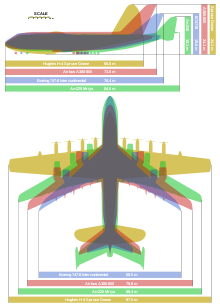 A size comparison of four large aircraft: Spruce Goose (gold), Antonov An-225 (green), Airbus A380 (pink), and a 747-8 (blue).
A size comparison of four large aircraft: Spruce Goose (gold), Antonov An-225 (green), Airbus A380 (pink), and a 747-8 (blue).
- List of megaprojects
- Related development
- Boeing 747SP
- Boeing VC-25
- Boeing E-4
- Boeing 747-400
- Boeing 747-8
- Boeing 747 LCF
- Shuttle Carrier Aircraft
- Aircraft of comparable role, configuration and era
- Airbus A380
- Airbus A340-600
- Antonov An-124
- Boeing 777-300ER
- Lockheed C-5 Galaxy
- Sukhoi KR-860
- Related lists
References
- Notes
- ^ a b c d e f g h Rumerman, Judy. "The Boeing 747." U.S. Centennial of Flight Commission, 2003. Retrieved: April 30, 2006.
- ^ a b c d e f "747 Model Orders and Deliveries data." The Boeing Company, December 2009. Retrieved: August 3, 2010.
- ^ "Boeing Commercial Airplanes prices." The Boeing Company. Retrieved: December 14, 2010.
- ^ a b "Great Planes-Boeing 747." Discovery Channel. Retrieved: October 28, 2007.
- ^ Branson, Richard. "Pilot of the Jet Age." Time, December 7, 1998. Retrieved: December 13, 2007.
- ^ "A380 superjumbo lands in Sydney." BBC, October 25, 2007. Retrieved: August 3, 2010. Quote: "The superjumbo's advent ends a reign of nearly four decades by the Boeing 747 as the world's biggest airliner."
- ^ Orlebar 2002, p. 50.
- ^ Wald, Matthew L. 747 "Fleet's Age at Issue During Flight 800 Hearing." New York Times, December 12, 1997. Retrieved: December 17, 2007.
- ^ Sutter 2006, p. 259.
- ^ "Technical Characteristics – Boeing 747–400", The Boeing Company. Retrieved: April 29, 2006.
- ^ "Airbus A350 XWB puts pressure on Boeing 777." Flight International. November 27, 2007.
- ^ a b c Norton 2003, pp. 5–12.
- ^ "Lockheed C-5 Galaxy, Partners in Freedom." NASA, 2000, see images in "Langley Contributions to the C-5". Retrieved: December 17, 2007.
- ^ Jenkins 2000, pp. 12–13.
- ^ a b Norris and Wagner 1997, p. 13.
- ^ "Boeing Multimedia Image Gallery 707". The Boeing Company. Retrieved: December 8, 2007.
- ^ "Innovators: Juan Trippe." PBS. Retrieved: December 17, 2007.
- ^ Sutter 2006, pp. 80–84.
- ^ "Air travel, a supersonic future?." BBC News, July 17, 2001. Retrieved: December 9, 2007.
- ^ a b Noland, David. "Passenger Planes: Boeing 747." "Info please." (Pearson Education). Retrieved: April 30, 2006.
- ^ Irving 1994, p. 359.
- ^ "Lockheed C-5 Galaxy, Partners in Freedom." NASA, 2000. Retrieved: December 17, 2007.
- ^ Irving 1994, p. 282.
- ^ a b c Sutter 2006, p. 93.
- ^ Mecham, M. "In review: 747, Creating the World's First Jumbo Jet and Other Adventures from a Life in Aviation." Aviation Week and Space Technology, Vol. 165, No. 9, September 4, 2006, p. 53.
- ^ "GE Aviation: CF6." GE Aviation. Retrieved: December 9, 2007.
- ^ a b Colson, Michael S. "Mechanical Engineering 100 Years of Flight." memagazine.org. Retrieved: December 9, 2007.
- ^ Sutter 2006, pp. 121, 128–131.
- ^ Guy and Wagner 1997, pp. 25–26.
- ^ Jenkins 2000, p. 19.
- ^ Sutter 2006, pp. 96–97.
- ^ Guy and Wagner 1997, p. 19.
- ^ Pascall, Glenn R. "Everett and Renton react differently to Boeing." Puget Sound Business Journal, September 26, 2003. Retrieved: December 17, 2007.
- ^ a b "Major Production Facilities – Everett, Washington." The Boeing Company. Retrieved: April 28, 2007.
- ^ a b c "747 Milestones." The Boeing Company. Retrieved: December 17, 2007.
- ^ Boyer, Tom. "Boeing legend Malcolm Stamper dies." Seattle Times, June 17, 2005. Retrieved: December 17, 2007.
- ^ Irving 1994, p. 310.
- ^ Irving 1994, p. 365.
- ^ Irving 1994, p. 383.
- ^ "History – "747 Commercial Transport." The Boeing Company. Retrieved: April 29, 2006.
- ^ "All but off the Ground." TIME, October 4, 1968. Retrieved: December 17, 2007.
- ^ "The Giant Takes Off." TIME. Retrieved: December 13, 2007.
- ^ "Boeing 747, the "Queen of the Skies," and "Celebrates 35th Anniversary." The Boeing Company, February 9, 2004. Retrieved: December 17, 2007.
- ^ Irving 1994, pp. 417–418.
- ^ Irving 1994, p. 428.
- ^ Uijt de Haag, P.A. et al. "Evaluating the risk from depleted uranium after the Boeing 747-258F crash in Amsterdam, 1992." Journal of Hazardous Materials, Volume 76, issue 1. (August 28, 2000), pp. 39–58." Retrieved: May 16, 2007.
- ^ van der Keur, Henk. "Uranium Pollution from the Amsterdam 1992 Plane Crash." Laka Foundation, May 1999. Retrieved: May 16, 2007.
- ^ Irving 1994, pp. 441–446.
- ^ "The Trouble with Jumbo." TIME, September 26, 1969.
- ^ Irving 1994, p. 436.
- ^ Aircraft Incident Report 5-0046 Retrieved 26 September 2011.
- ^ "The Paris Air Show in facts and figures." Reuters, June 14, 2007. Retrieved: June 3, 2011.
- ^ "Boeing 747–400." Jane's All the World's Aircraft, October 31, 2000. Retrieved: July 15, 2011.
- ^ Irving 1994, pp. 437–438.
- ^ "Jumbo challenge" Flightglobal.com, November 6, 1997. Retrieved: July 15, 2011.
- ^ Norris 1997, p. 48.
- ^ "Jumbo and the Gremlins." TIME, February 2, 1970. Retrieved: December 20, 2007.
- ^ "Breaking the Ground Barrier." TIME, September 8, 1967. Retrieved: December 19, 2007.
- ^ "Jumbo Beats the Gremlins." TIME, July 13, 1970. Retrieved: December 20, 2007.
- ^ "Ready or Not, Here Comes Jumbo." TIME, January 19, 1970. Retrieved: December 19, 2007.
- ^ Smith, Bruce A. "Boeing Shuns Very Large Jets While Aiming for Longer Range." Aviation Week and Space Technology, January 1, 2001, pp. 28–29.
- ^ 747X vs A380 "How to Reduce Congestion (PDF)." Department of Aerospace and Ocean Engineering, Virginia Tech. Retrieved: December 10, 2007.
- ^ "Airline reporting on fuel consumption." Miljominsteriet (Danish Environmental Protection Agency). Retrieved: December 13, 2007.
- ^ "Planes for Rough Weather." TIME, August 3, 1970. Retrieved: December 20, 2007.
- ^ "American Airlines History." American Airlines. Retrieved: June 3, 2011.
- ^ Davies 1990, p. 96.
- ^ "Aircraft Fleet." Delta Airlines. Retrieved: July 31, 2011.
- ^ "Turning Today's Challenges into Opportunities for Tomorrow." The Boeing Company. Retrieved: December 10, 2007.
- ^ Aboulafia, Richard. "Commercial Transport Market Still in Rough Shape." Aviation Week and Space Technology, March 1, 2004. Retrieved: December 10, 2007.
- ^ Wallace, James. "A380 buyer keeps mum about possible luxuries aboard cruise ship of the skies." Seattle Post-Intelligencer, January 24, 2005. Retrieved: June 3, 2011.
- ^ a b c d e f g h "Boeing 747 Classics." The Boeing Company. Retrieved: December 15, 2007.
- ^ "Solutions Center." The Boeing Company. Retrieved: December 13, 2007.
- ^ "Boeing 747SP." Airliners.net. Retrieved: November 23, 2007.
- ^ a b c d e f "Aircraft Owner's and Operator's Guide: 747-200/300 (PDF)."Aircraft Commerce. Retrieved: July 15, 2011.
- ^ a b c "Boeing 747–300." Airliners.net. Retrieved: June 3, 2011.
- ^ Lawrence and Thornton 2005, p. 54.
- ^ Salpukas, Agis. "J.A.L. Orders 15 More of Boeing's 747-400's." TIME, July 1, 1988. Retrieved: December 17, 2007.
- ^ a b Norris 1997, p. 88.
- ^ "El Al History page." El Al Airlines. Retrieved: October 18, 2007.
- ^ "Ask Us – Largest Plane in the World." Aerospaceweb.org, November 11, 2005. Retrieved: April 29, 2006.
- ^ a b c d e "Boeing Outlines the "Value" of Its 747 Plans." The Boeing Company, September 2, 1996. Retrieved: June 7, 2011.
- ^ a b "BA warms to A3XX plan." Flight International, March 19, 1997. Retrieved: December 17, 2007.
- ^ a b "Boeing Shelves 747X to Focus on Faster Jet." People's Daily, March 30, 2001. Retrieved: December 17, 2007.
- ^ Taylor, Alex III. "Boeing's Amazing Sonic Cruiser..." Fortune, December 9, 2002. Retrieved: December 17, 2007.
- ^ "Boeing Launches New, Longer-Range 747-400." The Boeing Company, November 28, 2000. Retrieved: December 17, 2007.
- ^ Holmes, Stanley. "Boeing's Reborn 747." Business Week, November 16, 2005.
- ^ "A380 superjumbo lands in Sydney." BBC News. Retrieved: December 10, 2007.
- ^ "Boeing Launches New 747-8 Family." The Boeing Company, November 14, 2005. Retrieved: December 17, 2007.
- ^ "Downhill for the jumbo." The Sydney Morning Herald, January 9, 2009. Retrieved: February 9, 2009.
- ^ Ostrower, Jon. "Boeing's 747-8F lifts off on maiden flight". Flightglobal.com, February 8, 2010.
- ^ "Boeing Sets 747-8 Freighter Delivery Schedule for Mid-Year 2011". The Boeing Company, September 30, 2010.
- ^ Trimble, Stephen (September 30, 2010). "Boeing pushes 747-8F delivery back to mid-2011". Air Transport Intelligence news via flightglobal.com. http://www.flightglobal.com/articles/2010/09/30/347996/boeing-pushes-747-8f-delivery-back-to-mid-2011.html. Retrieved February 22, 2011.
- ^ Bowers 1989, p. 508.
- ^ "Boeing 747–400 Airport Planning report, section 2.0, Boeing, December 2002 (PDF)." The Boeing Company. Retrieved: December 13, 2007.
- ^ "Boeing 747-100/200/300 Technical Specifications." The Boeing Company. Retrieved: December 13, 2007.
- ^ "Boeing 747–8 Technical Specifications." The Boeing Company. Retrieved: December 13, 2007.
- ^ Sutter 2006, pp. 128–131.
- ^ Sutter 2006, pp. 121–122.
- ^ "Special Report:Air India Flight 182." airdisaster.com. Retrieved: December 13, 2007.
- ^ "Her Majesty the Queen Against Ripudaman Singh Malik and Ajaib Singh Bagri." Supreme Court of British Columbia. Retrieved: December 13, 2007.
- ^ a b "ICAO Document 8643." International Civil Aviation Organization. Retrieved: February 6, 2011.
- ^ "Boeing 747." Aircraft Spotting. Retrieved: December 7, 2007.
- ^ "FAA Regulatory and Guidance Library (PDF)." FAA. Retrieved: December 12, 2007. See reference to Supplementary Type Certificates for freighter conversion.
- ^ Jenkins 2000, p. 40.
- ^ Kane 2004, p. 534.
- ^ Itabashi et al. 1995, p. 155.
- ^ Bowers 1989, pp. 516–517.
- ^ a b Airclaims Jet Programs 1995
- ^ "Truth of NANJING must be known."Japan Corporate News Network. Retrieved: December 15, 2007.
- ^ "Boeing 747-146B/SR/SUD aircraft", Airliners.net.
- ^ "JAL Aircraft Collection." Japan Airlines. Retrieved: December 15, 2007.
- ^ Airclaims Jet program 1995
- ^ "Saudia Orders 4 Boeing 747's." The New York Times. Retrieved: December 12, 2007.
- ^ Norris and Wagner 1997, pp. 52–53.
- ^ a b Airclaims Jet Programs 1995, p. 111.
- ^ Norris and Wagner 1997, p. 71.
- ^ a b c d "The Story of the Baby 747." 747sp.com. Retrieved: December 15, 2007.
- ^ Kane 2003, p. 546.
- ^ a b c "747 Airplane Characteristics for Airport Planning." The Boeing Company. Retrieved: December 15, 2007.
- ^ "Red, White And Q Farewell For Qantas Aircraft." Qantas, March 4, 2003. Retrieved: June 4, 2008.
- ^ "The SOFIA Boeing 747SP." NASA SOFIA Science Center. Retrieved: December 31, 2009.
- ^ "747 windows." Plexoft. Retrieved: December 15, 2007.
- ^ Norris and Wagner 1997, pp. 60–61.
- ^ Jenkins 2000, p. 43.
- ^ "Boeing 747 – About the 747 Family." The Boeing Company. Retrieved: December 6, 2007.
- ^ "Boeing 747–200." CivilAviation.eu. Retrieved: December 15, 2007.
- ^ "Air France F-BTDG Airfleets." Airfleets. Retrieved: December 6, 2007.
- ^ "747-2B3BM(SUD) Aircraft Pictures." Airliners.net. Retrieved: December 6, 2007.
- ^ Jenkins 2000, pp. 46, 50–53.
- ^ "747 background." The Boeing Company. Retrieved: December 13, 2007.
- ^ "747 Classics Technical Specifications." The Boeing Company. Retrieved: December 6, 2007.
- ^ "British Airways. (will accelerate the retirement of five 747-200s)". Air Transport World, October 10, 2001, p. 14.
- ^ "Qantas (will retire its fleet of five Boeing 747–200 aircraft)." Taipei Times, November 16, 2001. Retrieved: June 4, 2008.
- ^ "Boeing 747–300." airliners.net.
- ^ "Seven Series." The Boeing Company. Retrieved: December 15, 2007.
- ^ Jenkins 2000, p. 97.
- ^ "Boeing Delivers First 747-300 Special Freighter To Atlas Air." The Boeing Company. Retrieved: December 17, 2007.
- ^ "Technical Specifications – 747 Classics", The Boeing Company. Retrieved: July 11, 2008
- ^ Lawrence and Thornton 2005
- ^ "Seven series." The Boeing Company. Retrieved: December 17, 2007.
- ^ "Qantas's final Boeing 747–300 heads for graveyard." The Age. Retrieved: January 21, 2009.
- ^ "Assessment of Wingtip Modifications to Increase the Fuel Efficiency of Air Force Aircraft." National Academies Press, 2007, p. 33.
- ^ "JAL 2007." Japan Airlines. Retrieved: December 14, 2007.
- ^ a b c d "747 specifications", The Boeing Company. Retrieved December 16, 2007.
- ^ "Boeing 747–400 Freighter Family." The Boeing Company. Retrieved: December 17, 2007.
- ^ "Japan Airlines To Receive 100th Boeing 747 Aircraft." Japan Airlines, November 19, 1998. Retrieved: December 17, 2007.
- ^ "747-400 performance summary (PDF)." The Boeing Company, May 2010. Retrieved: December 21, 2010.
- ^ "Boeing 747-400ER Family." The Boeing Company. Retrieved: October 16, 2007.
- ^ "Boeing and Cathay Pacific Airways Launch 747-400 Special Freighter." The Boeing Company. Retrieved: July 15, 2011.
- ^ "First 747-400 Boeing Converted Freighter Redelivered to Cathay Pacific." The Boeing Company, December 19, 2005. Retrieved: June 7, 2011.
- ^ a b Wallace, James. "747-400 passenger is no more." Seattlepi.com, March 17, 2007. Retrieved June 7, 2011.
- ^ a b "Singapore Airlines Boeing 747–400 Fleet World's Largest." The Boeing Company, October 13, 1994. Retrieved: December 14, 2007.
- ^ "British Airways set for fleet revamp." The Boeing Company, August 2005. Retrieved: December 14, 2007.
- ^ a b "Final Boeing 747 Dreamlifter Enters Service." The Boeing Company. Retrieved: July 15, 2011.
- ^ "Evergreen Aviation press releases." Evergreen Aviation, July 20, 2007. Retrieved: December 17, 2007.
- ^ "Boeing 747 Large Cargo Freighter Completes First Flight." The Boeing Company, September 9, 2006.
- ^ "Boeing 747 Dreamlifter Achieves FAA Certification." The Boeing Company, June 4, 2007. Retrieved: December 17, 2007.
- ^ Mecham, Michael. "Boeing Puts Last Dreamlifter In Service". Aviation Week, February 16, 2010.
- ^ Steinke, Sebastian. "Boeing launches 747-8." Flug Revue, January 2006. Retrieved: July 15, 2011.
- ^ "Boeing 747–8 Freighter." Deagel. Retrieved: December 8, 2007.
- ^ "Boeing 747–8 Freighter Successfully Completes First Flight". The Boeing Company. Retrieved: July 15, 2011
- ^ "PICTURES & VIDEO: Boeing's 747-8F lifts off on maiden flight". Flight International. February 8, 2010. http://www.flightglobal.com/articles/2010/02/08/338138/pictures.html. Retrieved February 9, 2010.
- ^ a b Ostrower, Jon. "World Airliners: The ups and downs of the largest commercial aircraft". Flight International, November 2, 2011. Retrieved: November 14, 2011.
- ^ Norris, G. "Boeing freezes the 747-8I design." Aviation Week, 2007. Retrieved: December 8, 2007.
- ^ "First 747-8I Takes to the Air" AINOnline. Retrieved: March 26, 2011.
- ^ "Boeing C-19." Global Security. Retrieved: December 16, 2007.
- ^ "Boeing nets 57 new orders, including big VIP planes." Seattle Times. Retrieved: December 14, 2007.
- ^ a b "KC-33A: Closing the Aerial Refuelling and Strategic Air Mobility Gaps (PDF)." Air Power Australia Analysis APA-2005-02, April 16, 2005. Retrieved: December 17, 2007.
- ^ Hamilton, S. "Boeing advanced 747 as tanker (PDF)." Leeham Company, September 11, 2007. Retrieved: December 17, 2007.
- ^ Jenkins, Dennis R. B-1 Lancer, The Most Complicated Warplane Ever Developed. New York: McGraw-Hill, 1999. ISBN 0-07-134694-5.
- ^ "The Parasite Fighters". VectorSite, December 2009.
- ^ "Supplementary Type Certificate ST01912LA Installation and removal of internal tanks, associated systems and support structure for the aerial dispersant of liquids". US Federal Aviation Administration, October 27, 2006.
- ^ Jenkins 2000, pp. 69–71.
- ^ a b c Patterson, James W. "Impact of New Large Aircraft on Airport Design (PDF)." Federal Aviation Administration, March 1998. Retrieved: December 17, 2007.
- ^ a b "Boeing 747 Celebrates 30 Years In Service." The Boeing Company, September 2, 1996. Retrieved: December 17, 2007.
- ^ "Boeing Commits To Produce New Longer-Range 767-400ER." The Boeing Company, September 13, 2000. Retrieved: December 17, 2007.
- ^ "Customer Symposium Highlights Future Boeing 747 Models." The Boeing Company, June 29, 2000. Retrieved: December 17, 2007.
- ^ Morris, J. "Boeing In No Hurry to Launch 747X." Aviation Week, July 24, 2000. Retrieved: December 18, 2007.
- ^ "Boeing Launches New, Longer-Range 747-400." The Boeing Company. Retrieved: December 17, 2007.
- ^ "Boeing Offers New 747-400X Quiet Longer Range Jetliner." The Boeing Company, February 26, 2002. Retrieved: December 17, 2007.
- ^ "GE's CF6 Engine Models Tailored For Boeing's 747-400XQLR Wide-Body." GE Aviation, March 25, 2002.
- ^ Steinke, Sebastian. "Boeing Proposes 747-400X Quiet Longer Range." Flug Revue Online, May 2002. Retrieved: July 15, 2011.
- ^ "Orders and Deliveries search page." The Boeing Company. Retrieved: September 9, 2010.
- ^ "Boeing 747 incidents." Aviation-Safety.net, September 3, 2010. Retrieved: September 3, 2010.
- ^ "Boeing 747 hull-loss occurrences." Aviation-Safety.net, September 3, 2010. Retrieved: September 3, 2010.
- ^ "Boeing 747 Accident Statistics." Aviation-Safety.net, Retrieved: December 16, 2009.
- ^ "United States Updates Global Positioning System Technology". America.gov. February 3, 2006. http://www.america.gov/xarchives/display.html?p=washfile-english&y=2006&m=February&x=20060203125928lcnirellep0.5061609.
- ^ "Airlines Ordered to Cut Fuel-Tank Explosion Risk." Wall Street Journal, July 17, 2008, p. B5. Note: Cargo aircraft and smaller regional jets and commuter aircraft are not subject to this rule.
- ^ "Aircraft and Space Craft, Boeing 747–121." Museum of Flight. Retrieved: July 15, 2011.
- ^ "The Blue Sky." thebluesky.info. Retrieved: December 17, 2007.
- ^ "Historic Aircraft Lands at Air and Space Museum." WTOP News, January 16, 2007.
- ^ "Dark Roasted Blend: Abandoned Boeing 747 Restaurant (and Other Plane Conversions)." darkroastedblend.com, April 21, 2009. Retrieved: April 22, 2009.
- ^ "Historic 747 reaches grim end in South Korea". chicagotribune.com, December 13, 2010. Retrieved: December 13, 2010.
- ^ "The world’s first Jumbo Hostel finally opens!" Jumbohostel. Retrieved: July 15, 2011.
- ^ "Preliminary 747-8 Airport Compatibility." The Boeing Company. Retrieved: July 8, 2009.
- ^ "Lufthansa - Boeing 747-8 Roll out: 747-8 I vs. 747-400." Lufthansa. Retrieved: October 5, 2011.
- ^ "Calculating and Plotting Parasite Drag." Aerodynamics Text. Retrieved: July 15, 2011.
- ^ "Executive Decision." Movie Ramblings. Retrieved: December 17, 2007.
- ^ "Air Force One." Rotten Tomatoes. Retrieved: December 17, 2007.
- ^ Haenggi 2003, p. 9.
- ^ Sutter 2006, p. 279.
- ^ "Let's Groove." stlyrics.com. Retrieved: September 6, 2010.
- Bibliography
- Baum, Brian. Boeing 747-SP (Great Airliners, Vol. 3). Osceola, WI: Motorbooks International. ISBN 0-9626-7307-2.
- Birtles, Philip. Boeing 747-400. Hersham, Surrey: Ian Allen, 2000. ISBN 0-71102-728-5.
- Bowers, Peter M. Boeing Aircraft Since 1916. London: Putnam Aeronautical Books, 1989. ISBN 0-85177-804-6.
- Bowman, Martin. Boeing 747 (Crowood Aviation Series). Marlborough, Wilts.: Crowood, 2000. ISBN 1-86126-242-6
- Davies, R.E.G. Delta - An Airline and Its Aircraft: The Illustrated History of a Major U.S. Airline and the People Who Made It. McLean, VA: Paladwr Press, 1990. ISBN 0-96-264830-2.
- Haenggi, Michael. Boeing Widebodies. St. Paul, MN: MBI Publishing Co., 2003. ISBN 0-7603-0842-X.
- Dorr, Robert F. Boeing 747-400 (AirlinerTech Series, Vol. 10). North Branch, MN: Specialty Press, 2000. ISBN 1-58007-055-8.
- Falconer, Jonathan. Boeing 747 in Color. Hersham, Surrey: Ian Allen, 1997. ISBN 1-8826-6314-4.
- Gesar, Adam. Boeing 747: The Jumbo. New York: Pyramid Media Group, 2000. ISBN 0-94418-802-8.
- Gilchrist, Peter. Boeing 747-400 (Airliner Color History). Osceola, WI: Motorbooks International, 1998. ISBN 1-7603-0616-8.
- Gilchrist, Peter. Boeing 747 Classic (Airliner Color History). Osceola, WI: Motorbooks International, 2000. ISBN 0-7603-1007-6.
- Graham, Ian. In Control: How to Fly a 747. Somerville, MA: Candlewick, 2000. ISBN 0-7636-1278-2.
- Henderson, Scott. Boeing 747-100/200 In Camera. Minneapolis, MN: Scoval Publishing, 1999. ISBN 1-9022-3601-7.
- Ingells, Douglas J. 747: Story of the Boeing Super Jet. Fallbrook, CA: Aero Publishers, 1970. ISBN 0-8168-8704-7.
- Irving, Clive. Wide Body: The Making of the Boeing 747. Philadelphia: Coronet, 1994. ISBN 0-340-59983-9.
- Itabashi, M., K. Kawata and S. Kusaka. "Pre-fatigued 2219-T87 and 6061-T6 aluminium alloys." Structural Failure: Technical, Legal and Insurance Aspects. Milton Park, Abingdon, Oxon.: Taylor & Francis, 1995. ISBN 978-0-419-20710-8.
- Jenkins, Dennis R. Boeing 747-100/200/300/SP (AirlinerTech Series, Vol. 6). North Branch, MN: Specialty Press, 2000. ISBN 1-58007-026-4.
- Kane, Robert M. Air Transportation: 1903–2003. Dubuque, IA: Kendall Hunt Publishing Co., 2004. ISBN 0-7575-3180-6.
- Lucas, Jim. Boeing 747 - The First 20 Years. Browcom Pub. Ltd. ISBN 0-9461-4137-1.
- Lawrence, Philip K. and David Weldon Thornton. Deep Stall: The Turbulent Story of Boeing Commercial Airplanes. Burlington, VT: Ashgate Publishing Co., 2005, ISBN 0-7546-4626-2.
- March, Peter. The Boeing 747 Story. Stroud, Glos.: The History Press, 2009. ISBN 0-7509-4485-4.
- Norris, Guy and Mark Wagner. Boeing 747: Design and Development Since 1969. St. Paul, MN: MBI Publishing Co., 1997. ISBN 0-7603-0280-4.
- Minton, David H. The Boeing 747 (Aero Series 40). Fallbrook, CA: Aero Publishers, 1991. ISBN 0-8306-3574-2.
- Nicholls, Mark. The Airliner World Book of the Boeing 747. New York: Osprey Publishing, 2002. ISBN 0-9462-1961-3.
- Norton, Bill. Lockheed Martin C-5 Galaxy. North Branch, MN: Specialty Press, 2003. ISBN 1-58007-061-2.
- Orlebar, Christopher. The Concorde Story. Oxford: Osprey Publishing, Fifth edition, 2002. ISBN 1-85532-667-1.
- Pealing, Norman, and Savage, Mike. Jumbo Jetliners: Boeing's 747 and the Widebodies (Osprey Color Classics). Osceola, WI: Motorbooks International, 1999. ISBN 1-85532-874-7.
- Seo, Hiroshi. Boeing 747. Worthing, West Sussex: Littlehampton Book Services Ltd., 1984. ISBN 0-7106-030-4.
- Shaw, Robbie. Boeing 747 (Osprey Civil Aircraft series). London: Osprey, 1994. ISBN 1-85532-420-2.
- Shaw, Robbie. Boeing 747-400: The Mega-Top (Osprey Civil Aircraft)/ London: Osprey, 1999. ISBN 1-85532-893-3.
- Sutter, Joe. 747: Creating the World's First Jumbo Jet and Other Adventures from a Life in Aviation. Washington, DC: Smithsonian Books, 2006. ISBN 978-0-06-088241-9.
- Wilson, Stewart. Boeing 747 (Aviation Notebook Series). Queanbeyan, NSW: Wilson Media Pty. Ltd. ISBN 1-8767-2201-0 .
- Wilson, Stewart. Airliners of the World. Fyshwick, Australia: Aerospace Publications Pty Ltd., 1999. ISBN 1-875671-44-7.
- Wright, Alan J. Boeing 747. Hersham, Surrey: Ian Allen, 1989. ISBN 0-7110-1814-6.
- The Great Gamble: The Boeing 747. The Boeing - Pan Am Project to Develop, Produce, and Introduce the 747. Tuscaloosa: University of Alabama Press, 1973.
External links
 External images
External imagesCutaway diagrams of Boeing 747-100 
Hi-res cutaway diagram of Boeing 747-100 by Flight International 
747-100 cutaway by Flight International - Boeing 747 product page
- Boeing 747-8 page on Boeing's newairplane.com site
- Boeing 747 profile on FlightGlobal.com
- Boeing 747 Archive
- Video of 1968 rollout of 747 from British Movietone Digital Archive
Boeing airliners Piston-engined Jet-engined In development 737 MAX · 747-8I
Proposed Not developed Giant aircraft Production Aero Spacelines Super Guppy · Airbus A380-800 · Airbus Beluga · Antonov An-124 Ruslan · Antonov An-225 Mriya · Convair B-36 · Boeing 747 (SP/-400/-8I/8F/LCF) · Martin JRM Mars · Lockheed C-5 Galaxy
Prototypes Blohm & Voss BV 238 · Bristol Brabazon · Convair XC-99 · Hughes H-4 Hercules · Lockheed R6V Constitution · Saunders-Roe Princess
Concepts ProposedAbandonedWingless aircraft Luftschiffbau Zeppelin Hindenburg class (airship) · Fairey Rotodyne · Goodyear ZPG-3W (blimp) · Mil Mi-12 (helicopter)
Other related navboxes Boeing model numbers Aircraft 1 · 2 · 3 · 4 · 5 · 6 · 6D · 6E · 7 · 8 · 10 · 15 · 16 · 21 · 40 · 42 · 50 · 53 · 54 · 55 · 58 · 63 · 64 · 66 · 67 · 68 · 69 · 72 · 74 · 75 · 77 · 80 · 81 · 83 · 89 · 93 · 95 · 96 · 99 · 100 · 101 · 102
200 · 202 · 203 · 204 · 205 · 214 · 215 · 218 · 221 · 222 · 223 · 226 · 227 · 234 · 235 · 236 · 246 · 247 · 248 · 251 · 256 · 264 · 266 · 267 · 273 · 281 · 294 · 299 · 300 · 306 · 307 · 314 · 316 · 344 · 345 · 367 · 367-80 · 377 · 400 · 450 · 451 · 464 · 474 · 701
707 · 717 (i) · 717 (ii) · 720 · 727 · 733 · 737 · 747 · 757 · 767 · 777 · 787 · 2707
Turbine engines 502 · 520 · 550
Vessels 929
United States tri-service transport designations post-1962 C-1 · C-2 · C-3 · C-4 · C-5 · C-6 · C-7 · C-8 · C-9 · KC-10 · C-11 · C-12 · (C-13 not assigned) • C-14 · C-15 · (C-16 not assigned) • C-17 · C-18 · C-19 · C-20A/B/C/D · C-20F/G/H · C-21 · C-22 · C-23 · C-24 · C-25 · C-26 · C-27 / C-27J · C-28 · C-29 · (C-30 not assigned) • C-31 · C-32 · C-33 · C-35 · (C-36 not assigned) • C-37 · C-38 · C-40 · C-41 · (C-42 to C-44 not assigned) • KC-45 • KC-46
Lists relating to aviation General Aircraft (manufacturers) · Aircraft engines (manufacturers) · Airlines (defunct) · Airports · Civil authorities · Museums · Registration prefixes · Rotorcraft (manufacturers) · TimelineMilitary Accidents/incidents Records Categories:- Boeing aircraft
- United States airliners 1960–1969
- Quadjets
Wikimedia Foundation. 2010.

